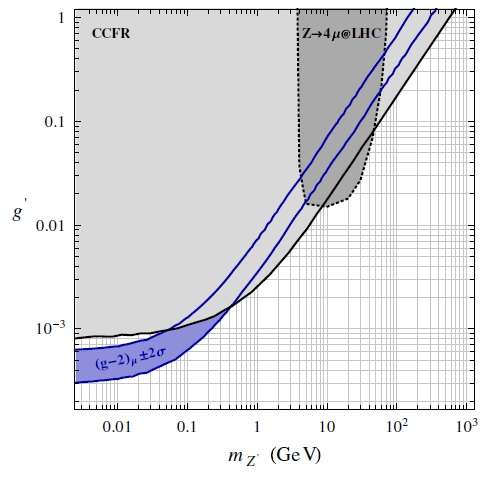Parameter space for the Z’ gauge boson. The light gray area is excluded at 95% C.L. by the CCFR measurement of the neutrino trident cross section. The dark gray region with the dotted contour is excluded by measurements of the SM Z boson decay to four leptons at the LHC. The purple region is the area favored by the muon g-2 discrepancy that has not yet been ruled out, but future high-energy neutrino experiments are expected to be highly sensitive to this low-mass region. Credit: Altmannshofer, et al. ©2014 American Physical Society
(Phys.org) —The standard model (SM) of particle physics has four types of force carrier particles: photons, W and Z bosons, and gluons. But recently there has been renewed interest in the question of whether there might exist a new force, which, if confirmed, would result in an extension of the SM. Theoretically, the new force would be carried by a new gauge boson called Z' or the "dark photon" because this "dark force" would be difficult to detect, as it would affect only neutrinos and unstable leptons.
"Much of the complexity and beauty of our physical world depends on only four forces," Wolfgang Altmannshofer, a researcher at the Perimeter Institute for Theoretical Physics in Waterloo, Ontario, told Phys.org. "It stands to reason that any additional new force discovered will bring with it interesting and unexpected phenomena, although it might take some time to fully appreciate and understand its implications."
Now in a new study published in Physical Review Letters, Altmannshofer and his coauthors from the Perimeter Institute have shown that the parameter space where a new dark force would exist is significantly restricted by a rare process called neutrino trident production, which has only been experimentally observed twice.
In neutrino trident production, a pair of muons is produced from the scattering of a muon neutrino off a heavy atomic nucleus. If the new Z' boson exists, it would increase the rate of neutrino trident production by inducing additional particle interactions that would constructively interfere with the expected SM contribution.
The new force could also solve a long-standing discrepancy in the muon g-2 experiment compared to the SM prediction. By coupling to muons, the new force might solve this problem.
However, the two existing experimental results of neutrino trident production (performed by the CHARM-II collaboration and the CCFR collaboration) are both in good agreement with SM predictions, which places strong constraints on any possible contributions from a new force.
In the new paper, the physicists have analyzed the two experimental results and extended the support for ruling out a dark force, at least over a large portion of the parameter space relevant to solving the muon g-2 discrepancy (when the mass of the Z' boson is greater than about 400 MeV). The results not only constrain the dark force, but more generally any new force that couples to both muons and muon neutrinos.
"We showed that neutrino trident production is the most sensitive probe of a certain type of new force," Altmannshofer said. "Particle physics is driven by the desire to discover new building blocks of nature, and ultimately the principles that organize these building blocks. Our findings establish a new direction where new forces can be searched for, and highlight the planned neutrino facility at Fermilab (the Long-Baseline Neutrino Experiment [LBNE]) as a potentially powerful experiment where such forces can be searched for in the future."
Overall, the current results suggest that LBNE would have very favorable prospects for searching for the Z' boson in the relevant, though restricted, regions of parameter space.
More information: Wolfgang Altmannshofer, et al. "Neutrino Trident Production: A Powerful Probe of New Physics with Neutrino Beams." PRL 113, 091801 (2014). DOI: 10.1103/PhysRevLett.113.091801
Journal information: Physical Review Letters
© 2014 Phys.org























